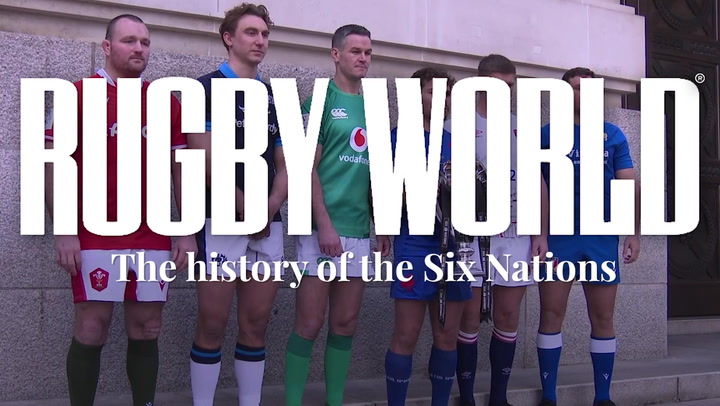Crossing the gainline is essential for a 12, writes columnist Paul Williams
Chasing trends and fashions is a tiring affair. One-minute sweatbands are being worn by 1970s tennis players, to stop sweat running onto their hands. The next, you’re a 28-year-old advertising creative living in Soho in 2005 and wearing sweatbands on each wrist just to go for a pint in the White Horse.
Rugby is no different. Trends come and go. The desire to have a single player who can play in the backs and forwards seems to emerge every 18 months. Eddie Jones of course famously wanted to turn wings into openside flankers. This month Stuart Barnes recently suggested Ben Earl play at 12 for England – which even though it raised a few eyebrows on social media, isn’t without its logic.
Read more: England top try-scorer
 Watch the video
Watch the videoPlaying a hybrid back row player at 12 for 80 minutes would of course be difficult. The defensive role alone is vastly different. But switching an eight to 12 for the occasional set-piece move is something genuinely worthy of consideration – it’s quite surprising that it isn’t done more. A particularly short trend was the very specific Italian peccadillo of playing a flanker at nine – it lasted seven days and was as sunsightly a fashion faux pas as Von Dutch.
But there is one trend in rugby, in Test rugby in particular, that isn’t going away. That is the role of the ‘gainline first’ inside the centre. Much like Nike Air Force One, they became popular in the mid-2000s and have been here to stay ever since. It’s important to differentiate between a ‘gainline first’ inside centre who can also pass and kick, and an inside centre who can only cross the gainline – which is possibly where the Ben Earl plan would fall down.
Currently Test rugby is jammed full of inside centres who are well over 100kgs, and most have far more than just a carrying game in their locker. This Guinness Six Nations’ tournament is the perfect sample. There is only one 12 who is well under 100kg and that is Nick Tompkins. The rest are the same weight as golf buggies, but significantly quicker off the mark. Just to clarify, this piece isn’t aimed at Nick Tompkins. He’s played well for Wales. In a squad that has had limited possession and is just four weeks into a total rebuild, Tompkins has arguably been one of their best players.

Nick Tompkins celebrates (Getty Images)
In many ways you could argue that George North and Nick T would benefit from a Channel Four type ‘job swap’. But that doesn’t seem likely at the moment. And until either Keiran Williams, Mason Grady, Max Llewelyn, or Eddie James tickle Warren Gatland’s fancy (or Joe Hawkins returns to Wales), then the Welsh 12 shirt appears to be Mr Tompkins’.
But as effective as Tompkins is a player, it’s difficult to ignore the size of others who are being picked in that position on a global level. Scotland have Sione Tuipulotu at 104kg, England have Ollie Lawrence at 100kg, Ireland have Bundee Aki at 102kg, or Stuart McCloskey at 114kg. France have Jonathan Danty at 110kg, Italy have Fredrico Mori at 106kg and Tommaso Menoncello at 101kg.
This of course isn’t a European only situation. South Africa have Damian de Allende and André Esterhuizen, the Wallabies have Samu Kerevi (when fit) and the All Blacks have the triple threat (kick, pass, run) monster that is Jordie Barrett.
It’s no surprise that the position has evolved this way. In the amateur era, 12s were the size of ‘normal’ backs because they were largely running at other normal backs. From the mid 2000s onwards that was no longer the case, because back row forwards were able to get to the ten/12 channel with regularity. Plus, the adoption of the ‘league’ blitz meant that 12 were now often forced back inside, towards where the bigger lads were lurking.

Felix Jones gets stuck into South Africa training (Getty Images)
In recent seasons, the blitz around the ten and 12 has become even more claustrophobic. Especially with Felix Jones’ even more precise blitz defence which is more difficult to evade than an ‘escape-room’ after eight pints.
But perhaps the most important benefit of a gainline 12 isn’t in what the individual 12 brings to the game, it’s what it allows their outside half to accomplish. Big 12s buy outside halves time. Having a legit ball carrier outside the ten is like having a builder’s skip on the driveway. If there’s anything you don’t fancy, or haven’t got time to dispose of properly, you can just throw it at the skip.
The almost five season long debate over the Ford/ Farrell and Smith/ Farrell axis is a classic example of how not playing a big unit at 12 makes supporters and coaches feel uneasy. If we’re honest that debate was never fully settled and with Owen Farrell now in France, it may well never be solved.
Whether you like your team’s 12 to have the ability to throw a miss three, to drill a perfect 50:22, or snap some defensive ankles with a sidestep, they must be able to cross the gainline first. And that doesn’t look like it’s going to change any time soon.
Download the digital edition of Rugby World straight to your tablet or subscribe to the print edition to get the magazine delivered to your door.





